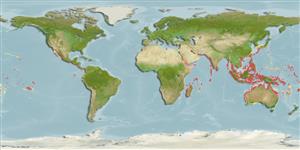Common names from other countries
Classification / Names / Names
Common names | Synonyms | Catalog of Fishes (gen., sp.) | ITIS | CoL | WoRMS
Environment: milieu / climate zone / depth range / distribution range
Ecology
Sessile; depth range 0 - 7 m (Ref. 102126). Tropical
Indian Ocean: from Iran to Madagascar, including the Persian Gulf, Aldabra, Seychelles, Mauritius and Réunion, east to India and south to Indonesia including Laccadive and Andaman Islands; Pacific Ocean: from China to the South China Sea south to Queensland, Australia including Federated States of Micronesia, Solomon Islands and Fiji, east to the Samoan Archipelago.
Length at first maturity / Size / Weight / Age
Maturity: Lm ? range ? - ? cm
Thalli erect, yellowish brown to dark brown in colour, attached by coarse branched holdfasts to rocky substrate, forming thick, huge colonies. Axes terete, muricate at the basal portion. Leaves are 6 to 12 mm long, consisting of a stalk, small vesicles and an expanded distal marginal blade outlined by coarse teeth; leaves triangular in outline or irregularly rounded in surface view; 3.5 to 9.0 mm across, sometimes deeply cut on one side, the cut often reaching the vesicle. Receptacular clusters 3 to 10 mm long, generally shorter and attached to the stalk of the leaves at 1/4 the distance from the main axis. This species is easily distinguished by its lax branched thalli, numerous branches, and small turbinate leaves with a length of about 1 cm or less. Thalli up to 1.5 m in height (Ref. 80758).
Used for human consumption, as fertilizer and insect repellant; contains minerals (Ca, K, Mg, Na, Cu, Fe, Zn); source of algin, tannins and phenols (Ref. 80758).
Guiry, M.D. and G.M. Guiry. 2009. (Ref. 80701)
IUCN Red List Status (Ref. 130435: Version 2024-1)
CITES status (Ref. 108899)
Not Evaluated
Not Evaluated
Threat to humans
Human uses
Fisheries: commercial
| FishSource |
Tools
More information
Age/SizeGrowthLength-weightLength-lengthMorphologyLarvaeAbundance
Internet sources
Estimates based on models
Preferred temperature
(Ref.
115969): 24.6 - 29.3, mean 28.4 (based on 3837 cells).
